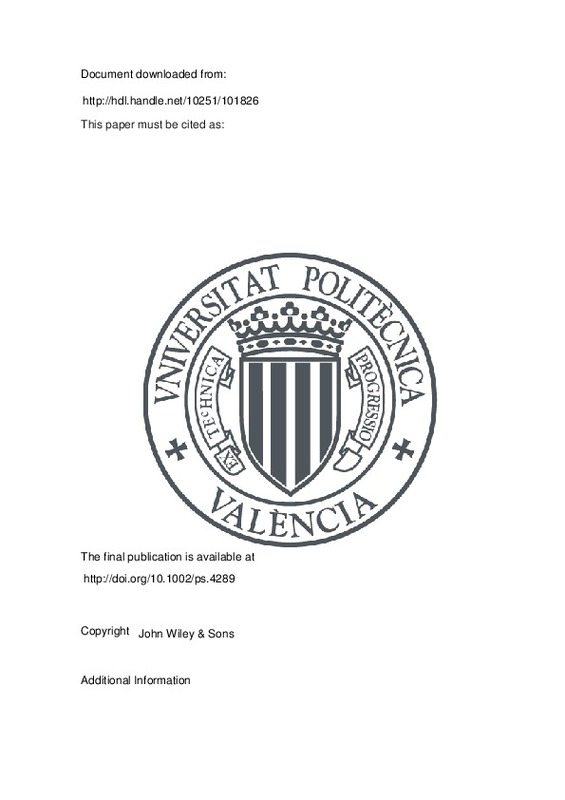JavaScript is disabled for your browser. Some features of this site may not work without it.
Buscar en RiuNet
Listar
Mi cuenta
Estadísticas
Ayuda RiuNet
Admin. UPV
Lures for red palm weevil trapping systems: aggregation pheromone and synthetic kairomone
Mostrar el registro sencillo del ítem
Ficheros en el ítem
| dc.contributor.author | Vacas González, Sandra
|
es_ES |
| dc.contributor.author | Melita, O.
|
es_ES |
| dc.contributor.author | Michaelakis, A.
|
es_ES |
| dc.contributor.author | Milonas, P.
|
es_ES |
| dc.contributor.author | Minuz, R.
|
es_ES |
| dc.contributor.author | Riolo, P.
|
es_ES |
| dc.contributor.author | Abbas, M.K.
|
es_ES |
| dc.contributor.author | Lo Bue, P.
|
es_ES |
| dc.contributor.author | Colazza, S.
|
es_ES |
| dc.contributor.author | Peri, E.
|
es_ES |
| dc.contributor.author | Soroker, V.
|
es_ES |
| dc.contributor.author | Livne, Y.
|
es_ES |
| dc.contributor.author | Primo Millo, Jaime
|
es_ES |
| dc.contributor.author | Navarro-Llopis, Vicente
|
es_ES |
| dc.date.accessioned | 2018-05-13T04:17:42Z | |
| dc.date.available | 2018-05-13T04:17:42Z | |
| dc.date.issued | 2017 | es_ES |
| dc.identifier.issn | 1526-498X | es_ES |
| dc.identifier.uri | http://hdl.handle.net/10251/101826 | |
| dc.description.abstract | [EN] BACKGROUNDThe optimisation of the lure is essential for the implementation of trapping systems to control insect pests. In this work, the response of the red palm weevil (RPW), Rhynchophorus ferrugineus Olivier, to increasing emission rates of its aggregation pheromone (ferrugineol) and the efficacy of a convenient synthetic kairomone based on fermentation odours (ethyl acetate and ethanol) have been evaluated in different years and locations along the Mediterranean basin. RESULTSIn general, although capture data and emission had noticeable variability among locations, significantly fewer RPW were captured in pyramidal Picusan (R) traps with the lowest ferrugineol emission rates tested (0.6-3.8 mg day(-1)). Captures increased rapidly with ferrugineol emission up to 4-5 mg day(-1); then, higher emission rates did not improve or reduce captures, up to the highest emission rate tested of 50.9 mg day(-1). Thus, there is no evidence of an optimum release rate corresponding to a maximum of RPW catches. Traps baited with the synthetic kairomone (1:3 ethyl acetate/ethanol) captured 1.4-2.2 times more total weevils than traps baited only with ferrugineol. Moreover, in most of the locations, the synthetic blend was at least as effective as the local coattractants used (plant material + molasses). CONCLUSIONSFerrugineol emission rate can vary in a wide range without significantly affecting RPW response. Coattractants based on fermenting compounds, ethyl acetate and ethanol, are able to improve the attractant level of ferrugineol and could be employed to replace non-standardised natural kairomones in RPW trapping systems after further optimisation of their proportions and doses. (c) 2016 Society of Chemical Industry | es_ES |
| dc.description.sponsorship | The research leading to these results has received funding from the 7th European Union Framework Programme under Grant Agreement FP7 KBBE 2011-5-289566 (PALM PROTECT). The authors would like to thank Yaakov Nakashe and Ami Landau for field assistance in the trials conducted in Israel, and Gikarakis Dimitrios and Fokas Vlasis for field assistance in the trials conducted in Greece. | |
| dc.language | Inglés | es_ES |
| dc.publisher | John Wiley & Sons | es_ES |
| dc.relation.ispartof | Pest Management Science | es_ES |
| dc.rights | Reserva de todos los derechos | es_ES |
| dc.subject | Rhynchophorus ferrugineus | es_ES |
| dc.subject | 4-methyl-5-nonanol | es_ES |
| dc.subject | Ethyl acetate | es_ES |
| dc.subject | Ethanol | es_ES |
| dc.subject | Mass trapping,monitoring | es_ES |
| dc.subject.classification | QUIMICA ORGANICA | es_ES |
| dc.title | Lures for red palm weevil trapping systems: aggregation pheromone and synthetic kairomone | es_ES |
| dc.type | Artículo | es_ES |
| dc.identifier.doi | 10.1002/ps.4289 | es_ES |
| dc.relation.projectID | info:eu-repo/grantAgreement/EC/FP7/289566/EU/Strategies for the eradication and containment of the invasive pests Rhynchophorus ferrugineus Olivier and Paysandisia archon Burmeister/ | es_ES |
| dc.rights.accessRights | Abierto | es_ES |
| dc.contributor.affiliation | Universitat Politècnica de València. Instituto Agroforestal Mediterráneo - Institut Agroforestal Mediterrani | es_ES |
| dc.contributor.affiliation | Universitat Politècnica de València. Departamento de Química - Departament de Química | es_ES |
| dc.description.bibliographicCitation | Vacas González, S.; Melita, O.; Michaelakis, A.; Milonas, P.; Minuz, R.; Riolo, P.; Abbas, M.... (2017). Lures for red palm weevil trapping systems: aggregation pheromone and synthetic kairomone. Pest Management Science. 73(1):223-231. https://doi.org/10.1002/ps.4289 | es_ES |
| dc.description.accrualMethod | S | es_ES |
| dc.relation.publisherversion | http://doi.org/10.1002/ps.4289 | es_ES |
| dc.description.upvformatpinicio | 223 | es_ES |
| dc.description.upvformatpfin | 231 | es_ES |
| dc.type.version | info:eu-repo/semantics/publishedVersion | es_ES |
| dc.description.volume | 73 | es_ES |
| dc.description.issue | 1 | es_ES |
| dc.identifier.pmid | 27060471 | |
| dc.relation.pasarela | S\328379 | es_ES |
| dc.contributor.funder | European Commission | es_ES |







![[Cerrado]](/themes/UPV/images/candado.png)

